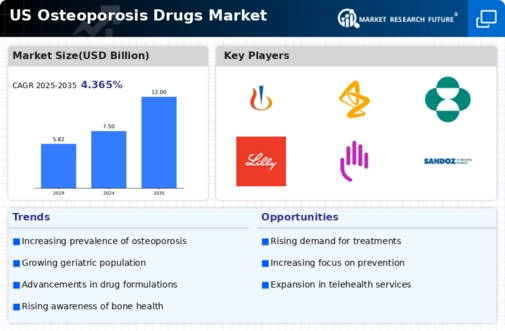Rising Healthcare Expenditure
The osteoporosis drugs market is positively influenced by the rising healthcare expenditure in the US. As healthcare spending continues to increase, there is a greater focus on preventive care and chronic disease management, including osteoporosis. In 2023, healthcare spending in the US reached approximately $4.3 trillion, with a significant portion allocated to pharmaceuticals. This trend suggests that more resources are being directed towards osteoporosis treatment, which may lead to increased accessibility and affordability of osteoporosis drugs. Furthermore, the osteoporosis drugs market could benefit from insurance coverage expansions and reimbursement policies that support the use of these medications, ultimately enhancing patient access to necessary treatments.
Advancements in Drug Formulations
Recent advancements in drug formulations are significantly impacting the osteoporosis drugs market. Innovative delivery systems, such as subcutaneous injections and oral medications with improved bioavailability, are enhancing patient compliance and treatment outcomes. For instance, the introduction of bisphosphonates and monoclonal antibodies has revolutionized the management of osteoporosis, providing effective options for patients. The market is projected to grow as pharmaceutical companies invest in research and development to create novel therapies that address unmet medical needs. The osteoporosis drugs market is likely to see an increase in the availability of combination therapies, which may offer synergistic effects and improved efficacy, thus attracting a broader patient base.
Increasing Prevalence of Osteoporosis
The osteoporosis drugs market is experiencing growth due to the increasing prevalence of osteoporosis among the aging population in the US. According to the National Osteoporosis Foundation, approximately 10 million individuals in the US are currently diagnosed with osteoporosis, while an additional 44 million have low bone density. This rising incidence necessitates effective treatment options, driving demand for osteoporosis drugs. As the population ages, the number of individuals at risk for fractures and related complications is expected to rise, further propelling the market. The osteoporosis drugs market is likely to benefit from increased awareness and screening initiatives aimed at early detection and management of the disease, which could lead to higher treatment rates and market expansion.
Technological Innovations in Diagnostics
Technological innovations in diagnostics are playing a crucial role in shaping the osteoporosis drugs market. Advanced imaging techniques, such as dual-energy X-ray absorptiometry (DXA) and quantitative computed tomography (QCT), are enhancing the accuracy of osteoporosis diagnosis. These innovations enable earlier detection of bone density loss, which is essential for timely intervention. As diagnostic capabilities improve, more individuals are likely to be identified as candidates for osteoporosis treatment, thereby increasing the patient pool for osteoporosis drugs. The osteoporosis drugs market is poised for growth as these technological advancements facilitate better screening and monitoring of patients, ultimately leading to improved treatment outcomes.
Growing Awareness and Education Initiatives
The osteoporosis drugs market is experiencing growth due to increasing awareness and education initiatives aimed at both healthcare providers and patients. Organizations such as the National Osteoporosis Foundation are actively promoting awareness campaigns that highlight the importance of bone health and the risks associated with osteoporosis. These initiatives are likely to lead to earlier diagnosis and treatment, thereby increasing the demand for osteoporosis drugs. Additionally, healthcare professionals are becoming more educated about the latest treatment options, which may result in more effective management of osteoporosis. The osteoporosis drugs market is expected to benefit from these efforts, as they contribute to a more informed patient population that seeks out treatment options.





















Leave a Comment